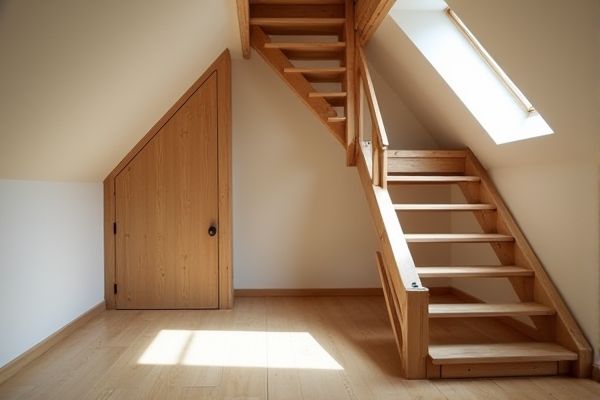
Access panels provide a discreet entry point to attic spaces, ideal for those prioritizing seamless design and limited space usage. Folding stairs offer a more convenient and sturdy solution for frequent attic access, making your climb safer and easier; explore the rest of the article to find the best fit for your needs.
Table of Comparison
| Feature | Access Panel | Folding Stairs (Attic) |
|---|---|---|
| Purpose | Provides entry to attic or crawl space via a removable or hinged panel. | Offers a retractable stair system for safe and easy attic access. |
| Installation | Simple to moderate, usually installed in ceilings or walls. | Moderate to complex, requires ceiling cutout and support for stairs. |
| Accessibility | Limited; requires ladder or step stool to enter attic. | High; built-in stairs provide direct, safe attic entry. |
| Space Efficiency | Minimal space impact when closed. | Folding design saves space but needs clearance for deployment. |
| Safety | Dependent on external ladders; less secure. | Integrated handrails and sturdy steps enhance safety. |
| Cost | Generally lower price, ranging from $50 to $200. | Higher cost, typically between $300 and $700. |
| Maintenance | Low maintenance; occasional cleaning. | Requires periodic inspection and tightening of hardware. |
| Best Use | Ideal for infrequent attic access or storage-only spaces. | Best for frequent attic access and carrying tools or materials. |
Introduction to Attic Entry Solutions
Attic entry solutions primarily include access panels and folding stairs, both designed to provide convenient and safe access to attic spaces. Access panels are typically compact and blend seamlessly with ceilings, offering a minimalist solution ideal for limited spaces. Folding stairs provide a sturdy, retractable access point that supports easier movement and safety when frequently accessing the attic.
What is an Access Panel?
An access panel is a built-in opening designed to provide convenient entry to attic spaces, typically featuring a flush, removable door integrated into ceilings or walls. It allows easy maintenance and inspection without the bulk or operational complexity of folding stairs, making it ideal for limited spaces. Access panels prioritize minimal intrusion and aesthetic concealment, often used in residential or commercial buildings to maintain seamless interior surfaces.
What are Folding Attic Stairs?
Folding attic stairs are a space-saving solution designed to provide easy access to attic spaces by folding up compactly against the ceiling when not in use. Typically made of wood or metal, these stairs consist of multiple hinged sections that fold into a small attic access panel, optimizing both safety and convenience. Compared to fixed access panels, folding attic stairs offer enhanced accessibility and functionality without requiring permanent structural changes.
Key Differences: Access Panel vs Folding Stairs
Access panels provide a simple, low-cost solution for concealing attic entry points while maintaining a flush, unobtrusive ceiling surface. Folding stairs offer a practical, space-saving option that provides safe, easy access to the attic with built-in steps that can be retracted when not in use. Your choice depends on whether you prioritize minimal visual impact (access panel) or convenience and accessibility (folding stairs).
Space and Installation Requirements
Access panels require minimal space and are typically installed flush with the ceiling, making them ideal for areas with limited headroom or tight quarters. Folding stairs demand more clearance both vertically and horizontally to fully extend, necessitating careful measurement of attic height and floor space prior to installation. Installation of access panels is simpler and less invasive, while folding stairs often require professional fitting to ensure safe operation and compliance with building codes.
Ease of Use and Accessibility
Access panels provide straightforward entry to attic spaces with a simple push or pull mechanism, making them highly accessible for quick inspections or maintenance. Folding stairs offer a more stable and secure means of access, allowing users to ascend and descend safely, especially when carrying tools or equipment. Your choice depends on whether easy entry or comfortable, safe access is your primary concern.
Safety Considerations
Access panels offer a fixed, secure entry point to attics, minimizing the risk of falls or structural instability. Folding stairs provide a more convenient solution but require regular maintenance and secure locking mechanisms to ensure user safety. Choosing between the two hinges on factors like load capacity, stability, and ease of emergency access.
Cost Comparison
Access panels for attic entry typically cost between $50 and $150, making them a budget-friendly option compared to folding stairs, which range from $200 to $800 depending on materials and design complexity. Installation costs for access panels are generally lower due to their straightforward mounting process, whereas folding stairs may require professional installation, increasing total expenses. Long-term, folding stairs provide greater functionality and accessibility, justifying the higher initial investment for frequent attic use.
Best Use Cases for Each Option
Access panels are best suited for spaces requiring minimal intrusion and easy maintenance, such as small attics or utility closets with limited headroom. Folding stairs excel in providing a safe, sturdy, and convenient means of entry for frequently accessed attics, especially when regular movement of bulky items is necessary. Residential buildings with tight space constraints benefit from access panels, while folding stairs are ideal for homes needing reliable, permanent attic access.
Choosing the Right Attic Access Solution
When choosing the right attic access solution, consider the frequency of use, space constraints, and safety requirements. Access panels offer a compact, low-cost option ideal for occasional access, while folding stairs provide a sturdy, convenient solution for regular use with better ease of entry and safety. Your decision should balance ease of installation, cost, and long-term functionality to ensure efficient attic access.
 homyna.com
homyna.com